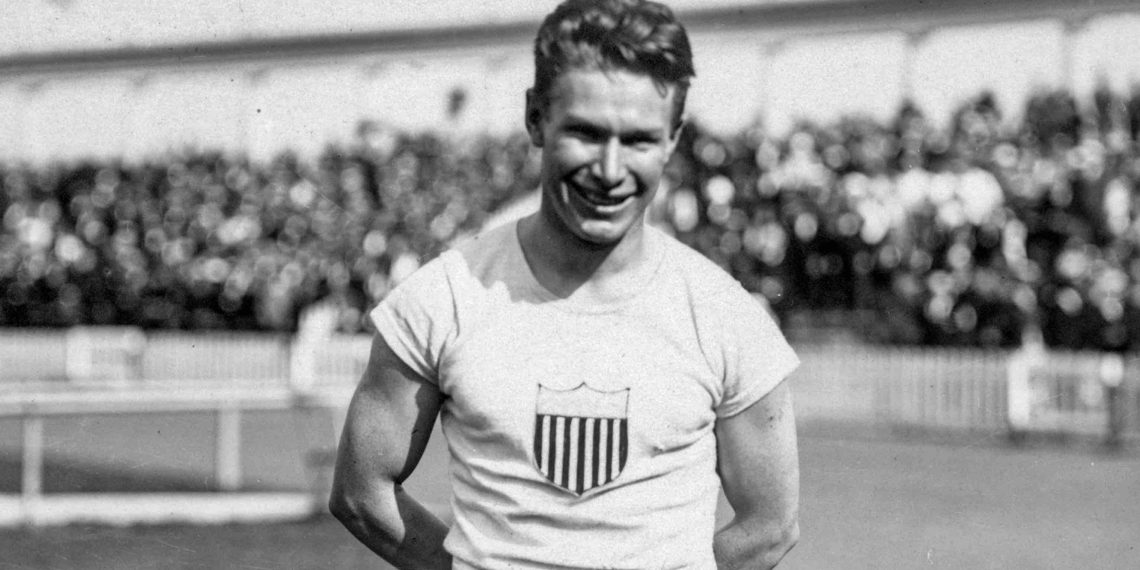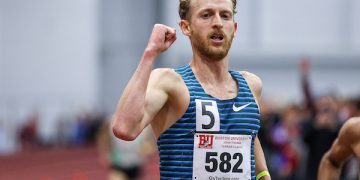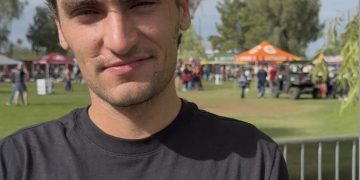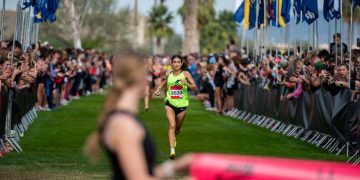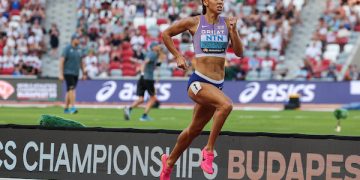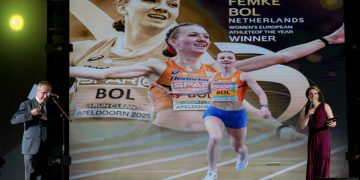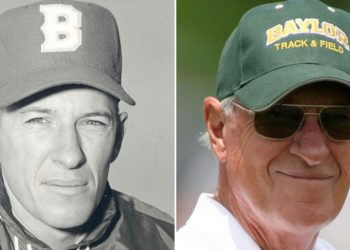Walt Murphy’s News and Results Service ([email protected])
RelatedPosts
This Day in Track & Field–June 18
1921—Charley Paddock runs 10.2 (10-1/5) for 110-yards in Pasadena, but AAU officials never submitted the mark as a World Record because Paddock actually ran longer than 100-meters (100.58m)! Paddock had won three medals the previous year at the Antwerp Olympics–gold in the 100 and 4×100, silver in the 200.
1921–The inaugural NCAA Championships were held at Stagg Field on the campus of the University of Chicago (17-18), with Illinois beating Notre Dame, 20-1/4 to 16-3/4, to win the team title.
Among the winners were Canadian Earl Thomson, the reigning Olympic champion, who won the 120y-hurdles for Dartmouth, equaling his own World Record of 14.4y (but never ratified), and Penn’s Earl Eby (880), the silver medalist in the 800-meters at the 1920 Olympics.
Eby joined the U.S. Air Force after his freshman year at Penn, and served in France during World War I before returning to school. He later worked for the Philadelphia Bulletin and covered Penn sports, including the Penn Relays, for 31 years.
Results: https://trackandfieldnews.com/wp-content/uploads/2018/05/1921.pdf
Penn Bio(Eby): https://archives.upenn.edu/exhibits/penn-people/biography/earl-william-eby
http://www.ustfccca.org/ncaa-100/the-first-ncaa-championship-track-field
1936—Finland’s Matti Järvinen threw 253-4 (77.23) in Helsinki to set his 10th (and final) World Record in the Javelin. Järvinen, the 1932 Olympic champion in the event, was the record holder from August 8, 1930 through August 25, 1938, the day that fellow Finn Yrjö Nikkanen threw 255-5 (77.87). Järvinen was there to see his record fall, finishing 2nd with a throw of 240-3 (73.23).
From his Wiki Bio: “Järvinen was the son of Verner Järvinen, an Olympic bronze medalist in Discus throw (1908). His brother Akilles Järvinen was a decathlon world record holder and two-time Olympic silver medalist (1928,1932). His other brother Kalle was a shot putter and also an Olympian. The exact distance of his gold-winning throw, 72.71 meters, was used as the height of the Helsinki Olympic Stadium in commemoration of his achievement.”
https://en.wikipedia.org/wiki/Matti_J%C3%A4rvinen
WR Progression(meters): http://en.wikipedia.org/wiki/Men’s_javelin_world_record_progression
Video(1932 Olympics): http://www.youtube.com/watch?v=Ud5lowOSYJU
1938–Glenn Cunningham (4:07.2) won the Mile at the 5th Annual Princeton Invitation over Archie San Romani (4:10.4). Cunningham (3:00.8) later finished a close 2nd in the 3/4-mile run to Wayne Rideout, who set a World Record of 3:00.4.
Race Highlight: http://www.youtube.com/watch?v=QS1JVcOOeHA
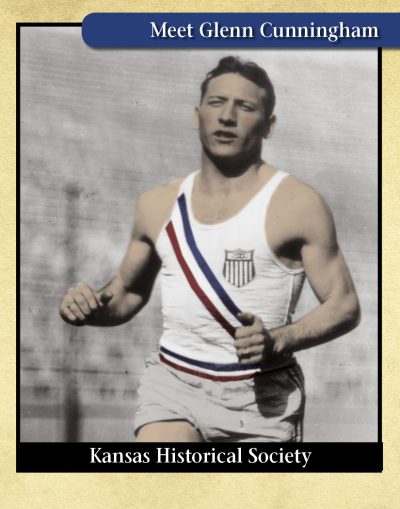
1938—USC (69-3/4) was an easy winner of the team title over Stanford (38) at the NCAA Championships in Minneapolis (June 17,18).
Pittsburgh junior John Woodruff (1:51.3), the reigning Olympic champion at 800-meters, won the 2nd of his 3 titles in the 800-meters.
USC sophomore Lou Zamperini beat Wisconsin senior Chuck Fenske, the defending champion, to win the Mile (4:08.3-4:08.8). Zamperini, who was a prisoner-of-war during WWII, was the subject of the book (and movie) Unbroken. He would win his 2nd title in the Mile in 1939.
For the 3rd year in a row, Ohio State senior Dave Albritton, the silver medalist at the 1936 Olympics, tied for 1st place in the High Jump (6-8 ¾ [2.05]MR). Sharing the title this year, just as he did in 1937, was Colorado senior Gus Cruter.
Rice sophomore Fred Wolcott, a future Hall-of-Famer, won the 120y- and 220y-Hurdles.
Oregon junior Mack Robinson, whose brother Jackie broke the color line in Major League Baseball, set a Meet Record of 21.3 in the 220y.
Wisconsin junior Walter Mehl out-dueled Notre Dame junior Greg Rice, the defending champion, to win the 2-mile (9:11.1-9:11.4) as both bettered the previous Meet Record.
Results(Finalists):
https://trackandfieldnews.com/wp-content/uploads/2020/04/1938.pdf
NY Times(for subscribers):
Day 1: https://timesmachine.nytimes.com/timesmachine/1938/06/18/98151961.html?auth=login-email&pageNumber=9
Day 2: https://timesmachine.nytimes.com/timesmachine/1938/06/19/98152981.pdf?pdf_redirect=true&ip=0
1944—And then there were none! In one of the more bizarre incidents in the long history of the U.S. Championships, held this year at NY’s Downing Stadium on Randall’s Island, six sprinters qualified for the final of the Men’s 100-Meters, but none made it to the finish line!
A series of false starts led to the disqualification of all six runners. First to be tossed by veteran starter Jack Lavelle were Herb Douglas and Herb Thompson, a 3-time U.S. Indoor Champion at 60-yards. Then it was Buddy Young and Eddie Conwell, the 1944 U.S. Indoor Champion, and finally, Barney Ewell and Bill Mathis. “There will be no 100-Meter Champion this year”, proclaimed Lavelle.
The powers-that-be prevailed on a reluctant Lavelle to allow the 6 men to run in an exhibition race, which was won by Young, whose name appears in the official USATF list of past champions!
Among the more traditional winners at the meet:
In the last competition of his career, Cornelius “Dutch” Warmerdam won his 6th U.S. title in the Pole Vault with a clearance of 15-feet even (4.57)
A week after winning NCAA titles in both events, Morgan State’s (and the Shore A.C.’s) Elmore Harris, in his 1st year running track, won the 400 (48.0/beating Jamaica’s Herb McKenley) and the 200m-Hurdles (24.1).
Harris, who would win a 2nd U.S. title in the 400 in 1946 (again beating McKenley), gave up a chance to contend for a berth on the 1948 Olympic team when he signed a contract to play professional football (his first love) with the Brooklyn Dodgers (not to be confused with the baseball team!).
A day after winning the Junior 100, Charley Parker, a 17-year old schoolboy from Texas, edged Eddie Conwell to win the Senior 200 in 21.3. According to the NY Times, it was Parker’s 51st consecutive win. He served 3 years in the U.S. Army before he went on to compete for the University of Texas, where he was the 1950 NCAA Champion at 220-Yards.
NY Times(for subscribers): https://timesmachine.nytimes.com/timesmachine/1944/06/19/86863135.pdf?pdf_redirect=true&ip=0
Young: https://en.wikipedia.org/wiki/Buddy_Young
Parker: https://texassports.com/honors/hall-of-honor/charley-parker/739/kiosk
https://www.legacy.com/obituaries/sanantonio/obituary.aspx?n=charles-parker&pid=142309065&fhid=15386
Harris: https://www.newspapers.com/clip/11493187/elmore-harris-prefers-football-to/
1949—USC (55-2/5) beat crosstown rival UCLA (31) at the NCAA Championships in the L.A. Coliseum (June 17,18). This was the 1st of 7 straight team titles for the Trojans.
USC senior Mel Patton, the 1948 Olympic gold medalist in the 200m and 4×100, won the 100y (9.7) and the 220y (20.4-straight). It was his 3rd straight win in the 100 and his 2nd in the longer sprint (races were 100/200 meters in 1948). Finishing 2nd in both sprints this year was Seton Hall sophomore Andy Stanfield (9.8, 20.5), who would win the 200-meters at the 1952 Olympics.
Cornell sophomore Charlie Moore (47.0) edged NYU junior Reggie Pearman (47.1) to win the 440y. Moore would win the 400-Meter Hurdles at the 1952 Olympics.
Ohio State senior Mal Whitfield, the 1948 Olympic gold medalist in the 800 (he’d win again in 1952), won the 880y in 1:50.3 (=MR) after winning at 800-meters in 1948.
Penn State senior Horace Ashenfelter won the 2-mile in 9:03.9 and would win the Steeplechase at the 1952 Olympics.
Wisconsin senior Don Gerhmann (4:09.6) won the 2nd of his 3 titles in the Mile (1500-1948).
Yale junior Jim Fuchs won the Shot Put with a toss of 56-1 ½ (17.105) and would go on to set 4 World Records in the event.
Stanford junior Bud Held won the 2nd of his 3 titles in the Javelin (224-8 [68.48]).
Results(Finalists): https://trackandfieldnews.com/wp-content/uploads/2020/04/1949.pdf
NY Times(for subscribers)
Day 1: https://timesmachine.nytimes.com/timesmachine/1949/06/18/86773301.pdf?pdf_redirect=true&ip=0
Day 2:
https://timesmachine.nytimes.com/timesmachine/1949/06/19/96461231.pdf?pdf_redirect=true&ip=0
Held Family & The Javelin:
1955— It was a neighborhood battle at the NCAA Championships, held at the L.A. Coliseum (June 17,18), with USC (42) winning its 7th straight team title, with UCLA (34) finishing 2nd. (The Bruins would end USC’s streak the following year).
Fordham senior Tom Courtney set a Meet Record of 1:49.5 in the 880y and went on to win Olympic gold in the 800-meters in 1956.
Oklahoma A&M (now State) junior J.W. Mashburn (46.6) won the 440y over Villanova sophomore Charlie Jenkins (46.9). Mashburn would win again in 1956, with Jenkins finishing 3rd, and the two would team up (along with Tom Courtney and Lou Jones) on the U.S. team that won the 4×400 relay at the Melbourne Olympics (Jenkins also won gold in the 400).
Indiana sophomore Milt Campbell, who won the silver medal in the Decathlon at the 1952 Olympics (and gold in 1956), won the 120y-Hurdles in 13.9 (=MR).
A future Olympic gold medalist (1960) was Villanova sophomore Don Bragg, who set a Meet Record of 15-1 (4.60) in the Pole Vault.
Kansas junior Bill Nieder won the Shot Put (57-3 [14.45]) and went on to win the silver medal in Melbourne and gold 4 years later in Rome.
Oregon’s Jim Bailey, a sophomore from Australia, beat teammate Bill Dellinger, the defending champion, to win the Mile (4:05.6-4:06.4). Bailey would become the first Duck to break 4-minutes for the mile when he ran 3:58.6 in 1956, and Dellinger later became Bill Bowerman’s assistant coach at Oregon and then succeeded him as the head coach.
Northwestern senior Jim Golliday won the 100y (9.6) and the 220 (21.1). He had tied the World Record of 9.3 for the 100 the previous month.
LaSalle senior Al Cantello set a Collegiate Record of 245-3 (74.75?) in the 5th round of the Javelin, but was knocked down to 2nd place after Kansas junior Les Bitner responded with a throw of 246-1 (75.00?).
Results(Finalists): https://trackandfieldnews.com/wp-content/uploads/2020/04/1955.pdf
NY Times (for subscribers): https://timesmachine.nytimes.com/timesmachine/1955/06/19/82201523.pdf?pdf_redirect=true&ip=0
1955—The star of the U.S. Women’s Championships in Ponca City, Oklahoma, was Mae Faggs, a senior at Tennessee State and already a veteran of two Olympics (she would make her 3rd Olympic team in 1956). The future Hall-of-Famer won the 100y (10.7-American Record), the 220y (25.1) and anchored the winning 440y-relay (49.1).
Another American Record was set by Tuskegee Institute’s Mildred McDaniel, who broke her own mark in the High Jump with a clearance of 5-6 ½ (1.69). She joined Faggs in the Hall of Fame in 1983.
With the 1956 Olympics on the horizon, the meet drew many aspiring Olympians from around the country, including some high school athletes who had few opportunities to compete in their hometowns (Read the SI article for more on the subject).
Sports Illustrated Vault:
https://vault.si.com/vault/1955/07/04/the-girls-at-ponca-city
1960—10 Meet Records were tied or broken at the NCAA Championships in Berkeley,CA (June 17, 18), and a number of athletes went on to compete at the Rome Olympics later in the year.
Tennessee State sophomore Ralph Boston won the Long Jump (25-5 ¾ [7.765]) and went on to win gold in Rome.
USC sophomore Dallas Long won the first of his 3 titles in the Shot Put (61-9/MR [18.82]). (bronze in Rome, gold in Tokyo).
Boston University sophomore John Thomas, the World Record holder in the event, won the High Jump with a clearance of
7-0 (2.135 [MR]). Favored heading into the Olympics, he would wind up with the bronze medal (won silver in 1964).
Other winners who would medal in Rome were Kansas senior Cliff Cushman in the 400-Meter hurdles (50.8/silver), Missouri senior Dick Cochran in the Discus (188-3 [57.38?/bronze]), and Illinois senior George Kerr, who set a Collegiate Record of 1:46.4 in the 800. The native of Jamaica, representing the West Indies, won the bronze medal in Rome. Finishing behind him in Berkeley were Cal senior Jerry Siebert (1:46.9) and Stanford senior Ernie Cunliffe (1:47.6), both of whom would join Tom Murphy on the U.S. team. All 3 would be eliminated in the semi-final round in Rome.
Oregon sophomore Dyrol Burleson won the 1st of his 3 titles in the 1500/mile (3:44.2/MR) and would finish 6th in the Olympic final.
Kansas senior Charlie Tidwell won the 100 (10.2/=MR) and 200 (20.8), but a later injury put an end to his Olympic dream. His 2 wins helped Kansas (50) win the team title over USC (37).
Oklahoma junior J.D. Martin won the Pole Vault (14-9 [4.50]) and would later become the coach at his alma mater.
Results(Finalists): https://trackandfieldnews.com/wp-content/uploads/2018/06/1960.pdf
1961–Valeriy Brumel cleared 7-3 ¾ (2.23m) in Moscow to equal John Thomas’s World Record in the High Jump. However, Thomas’s mark was accepted metrically by the IAAF as 2.22, which, using current conversion tables, equates to 7-3 1/4. Brumel would raise the record five more times during his legendary career.
WR Progression: http://en.wikipedia.org/wiki/Men’s_high_jump_world_record_progression
NY Times Obituary(2003):
Tribute Video: http://www.youtube.com/watch?v=9r0hdHV95sU
1963—Jim Grelle ran 3:55.4 for the Mile in Vancouver to break Jim Beatty’s 2-year old American Record of 3:55.5
Oregon Hall of Fame Bio: https://goducks.com/honors/hall-of-fame/jim-grelle/99
1966—Washington State sophomore Gerry Lindgren won the first of his 3 distance-doubles at the NCAA Championships in Bloomington,IN (June 16-18). He won the 6-Mile (28:07.0) on Thursday, then won the 3-Mile (13:33.7/Meet Record) on Saturday.
Texas A&M junior Randy Matson was also a double champion, winning the Shot Put (67-1 ½ [20.46]) and Discus (197-0 [60.04]) with Meet Record performances. He would repeat the double in 1968.
San José State coach Bud Winter was counting on sprint sensation Tommie Smith to score a lot of points for his team. After qualifying on Thursday for both finals, he finished 3rd in the Long Jump (24-8 ¼ [7.52]) and 2nd (to Nebraska’s Charlie Greene-9.54) in the 100y (9.60) on Friday. He also won his heat of the 220y in a wind-aided 20.2.
His next race was Saturday’s final of the 440y-relay. Running the anchor leg, he appeared to be on his way to bringing his team home in 1st place when he suddenly hopped on one foot, obviously the victim of a muscle injury. He almost stopped, but managed to cross the finish line in 3rd place. But he was done for the day, scratching from the final of the 220y, an event in which he had set World Records of 19.5 (straight) and 20.0 (turn) earlier in the season,
Villanova sophomore Dave Patrick (4:02.1) beat Oklahoma State junior Tom Von Ruden (4:02.4) in the mile. 4th was Oregon junior Wade Bell (4:02.9), who would win the 880y the following year.
UCLA won the team title in dominating fashion, beating runnerup BYU by 48 points (81-33)
Results(Finalists): https://trackandfieldnews.com/wp-content/uploads/2020/04/1966.pdf
NCAA History
Past Champions(Through 2022)
Men: http://fs.ncaa.org/Docs/stats/track_outdoor_champs_records/2022/D1Men.pdf
Women: http://fs.ncaa.org/Docs/stats/track_outdoor_champs_records/2022/D1Women.pdf
USTFCCCA: http://www.ustfccca.org/meets-results/meet-history?series=3369
T&F News
https://trackandfieldnews.com/historical-results/a-history-of-the-ncaa-championships-1921-2018/
1969—Jorma Kinnunen threw the “old” javelin 304-1 (92.70) in Tampere to return the World Record to Finland, the unofficial “home” of the event, after an 11-year gap. Seven Finnish throwers have accounted for 18 IAAF World Records since 1919.
WR Progression: http://en.wikipedia.org/wiki/Men’s_javelin_world_record_progression
1978—When you mention “Iffley Road” to a hard-core track fan, they most likely will recall that Roger Bannister ran history’s first sub-4 minute mile there in 1954. But few would remember who was the 2nd man to break 4-minutes on the famed track. It was none other than Craig Masback, the former CEO of USATF and Nike’s former Director of Business Affairs for Global Sports Marketing. I asked Masback, who was attending Oxford at the time, to recall how the event took shape and here’s what he had to say:
“I had won the 1500 and 800 at the “Varsity Match” (Oxford vs Cambridge) in May and was chosen to represent the Achilles Club (a combined Oxford and Cambridge team) in a June 18 match at Iffley Road with a combined Penn and Cornell team. The matches between Achilles and combined Ivy League teams dated back to the 1890s.
The event in the match was scheduled to be a 1500 meters. About a week before the match, it was announced that Roger Bannister would attend the match because the groundskeeper who had prepared the track on May 6, 1954, was retiring and they wanted to honor him. I had run some good early season races and thought I might have a shot at running my first sub-four and called the man organizing the match, Charles Wenden, the man kneeling at the finish line in the photos of Bannister running the first sub-four-minute mile. I proposed changing the race to the mile distance in Sir Roger’s honor, reminding him that no one had broken four at Iffley Road since May 6, 1954. He agreed.
The night before the race I had dinner with Tom Murray of Penn. We had raced often while I was at Princeton and were good friends. He told me he wasn’t in very good shape and when he heard I was running well, he offered to pace me for the first three laps.
In the race, Tom delivered splits of 59, 2:01, 3:03, very similar to what Bannister’s pacemakers ran in 1954. With a lap to go, I was on my own. I remember clearly running down the backstretch and reviewing how I was feeling against how Bannister had described the last lap in his autobiography. I worked hard to the finish line.
After a pause for the timers to consult with one another, the public address announcer said, “It has happened again,” saying that I had won in 3:59.6, leaving Bannister’s track record in place. Bannister came out on the track to congratulate me and we had our picture taken together. He told me that he was sitting with my thesis advisor, Sir Norman Chester, and that Sir Norman had taken some credit for coaching me. Our picture was on the front page of the Oxford Mail local newspaper. I received a hand-written note from Sir Roger the next week inviting me to a party at his home after I ran at the AAA Championship at Crystal Palace. I ran a poor race at the AAA’s, going from seventh to third in the last 100 meters but losing a race I probably should have won. When I arrived at the Bannisters’ house, I was greeted at the door by his youngest daughter who said, “Oh, we were just watching you run on TV, my father said you ran a really stupid race.” It was good having your race critiqued by history’s most famous miler!
I remained in touch with Sir Roger over the years and attended both the 40th and 50th anniversary celebrations of his historic achievements. For the 40th, they had a “handicap” mile race at Iffley Road featuring almost all of the living world record holders and some invitees. I managed to get invited and having already lost to all of the milers of my era, I was able to lose to Jim Ryun, Michel Jazy, Peter Snell, Herb Elliott, Kip Keino, and others in a single race!”
More Details Here: http://bringbackthemile.com/news/detail/my_first_sub_411
1984— Edwin Moses, the World Record holder and the 1976 Olympic champion, qualified for his 2nd Olympic team with his win in the Men’s 400-Meter Hurdles at the U.S. Olympic Trials in the L.A. Coliseum (June 16-24). It was his 89th straight win in a streak that would ultimately reach 107 (finals)! Danny Harris finished 2nd in 48.11, just short of the World Junior Record of 48.02 that he ran in the semi-finals, and 3rd was Tranel Hawkins (48.28). Next across the line were Andre Phillips (48.62) and David Patrick (48.99). Moses and Harris would finish 1-2 at the Olympics.
Evelyn Ashford (11.18) overtook Alice Brown (11.20) to win the Women’s 100, with Jeanette Bolden (11.24) grabbing the 3rd spot on the team. Ashford and Brown would repeat their finish at the Olympics.
Duncan Atwood unleashed a monster throw of 306-7 (93.44) to secure his place on the team in the Javelin, and would b joined on the return trip to the Coliseum for the Olympics by World Record holder Tom Petranoff (278-8 [84.94]) and Steve Roller (272-4 [83.00]).
Bob Roggy had the longest throw in the qualifying round–280-8 (85.56), but only finished 7th in the final.
Results/Notes: https://trackandfieldnews.com/wp-content/uploads/2018/03/1984.pdf
1987—Joe Dial cleared 19-6 ½ (5.96) in Norman, Oklahoma, to set his 8th (and final) American record in the Pole Vault.
https://en.wikipedia.org/wiki/Joe_Dial
1988(16-18)–This was the last year that two separate meets, the U.S. Championships and the U.S. Trials, were held in an Olympic year. Many stars skipped the Nationals, but among the winners in Tampa, Florida, who went on to make the U.S. Olympic team were Mark Everett (800), Brian Diemer (Steeplechase), Doug Padilla (5000), Roger Kingdom (110-hurdles), Mac Wilkins (Discus), Gwen Torrence (200) Joetta Clark (800), Vicki Huber (1500-made the team in the 3000), and Lynn Jennings (3000-made the team in the 10,000).
1994—Seven years to the day after Joe Dial improved his own American Record to 19-6 ½ (5.96) in Norman, Oklahoma, Scott Huffman, using the “Huffman Roll” (check the video), jumped 19-7 (5.97) to set a new mark at the U.S. Championships in Knoxville, Tennessee.
Mike Powell, the World Record holder in the Long Jump, needed a final-round leap of 28-5 3/4w (8.68m) to beat Kareem Streete-Thompson’s 28-4 1/4w (8.64). Jackie Joyner-Kersee won the Women’s Long Jump (23-5 1/4w [7.14]) and the 100-meter hurdles (12.88).
Huffman
PV Video: http://www.youtube.com/watch?v=u4yKRw9LEL8
1995—Among the winners and notable events at the U.S. Championships in Sacramento (June 14-18), the selection meet for the World Championships in Gothenburg, Sweden (eventual World Champions in bold):
…


